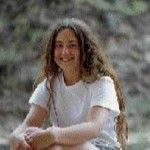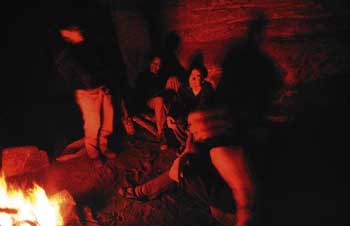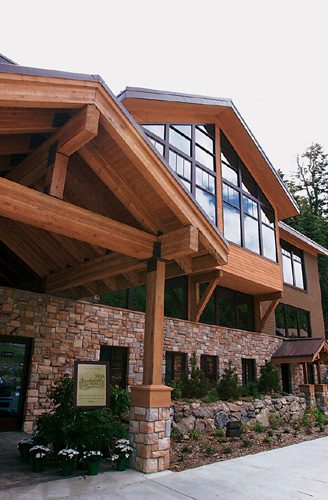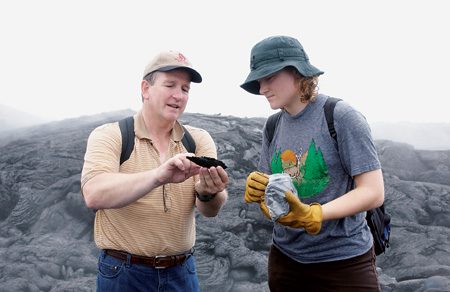By John S. Bennion
One BYU class takes writing to the extreme—literally. On the tops of mountains and in the depths of canyons, students in a combined English/recreation management class pull journals from backpacks and jot notes of their experiences. But the notes reveal more than the scenery of the area and the adventure of the excursion. Through their meditations in the mountains, the students explore nature and discover themselves.
 It’s dusk on the flank of Mt. Nebo, a triple peak 30 miles south of Provo. Rain has fallen the previous few days and clouds still threaten to prevent our climb the next morning. Another professor and I, with our class of BYU students, are setting up camp—a few of us work at pitching tents on the slope, while others explore the upward trail; many simply sit and breathe the scent of moist pine.
It’s dusk on the flank of Mt. Nebo, a triple peak 30 miles south of Provo. Rain has fallen the previous few days and clouds still threaten to prevent our climb the next morning. Another professor and I, with our class of BYU students, are setting up camp—a few of us work at pitching tents on the slope, while others explore the upward trail; many simply sit and breathe the scent of moist pine.
After the overnight trip, Ranae Waisath, a molecular biology major, wrote a summary in her journal:
Friday night I went camping with my Wilderness Writing class; Saturday we woke up and hiked to the top of Mt. Nebo—the highest mountain in the Wasatch Front. It was a rigorous hike, but breathtakingly beautiful and absolutely worth every effort and every sore muscle I now suffer from. The mountainside was aflame with changing leaves: yellow-leaved aspens and red- and orange-leaved maples. Stunning. And then to be atop the peak and look all around the beautiful world; it was exhilarating.
I cannot be amidst the grandeur of nature without remembering the temple and the things I learn there about the plan of salvation and the divinity of this earth and all creation. It is a wonderful reminder.
Ranae’s experience was one among many in Wilderness Writing, a cooperative venture between me—an associate professor of English—and Burton K. Olsen—a professor in the Recreation Management and Youth Leadership Department.
In the recreation side of the class, students explore Utah’s mountain and desert environments—hiking, backpacking, spelunking, canoeing, snowshoeing, cross-country skiing, and sleeping in snow caves; in the English portion they craft their experiences into personal narratives. Linking recreation to writing fulfills BYU’s unique mission, educating the whole soul—physically, intellectually, and spiritually.
HIKING BOOTS AND TENTS, PAPER AND PENS
“We spend one-third our life working and another third sleeping,” Olsen says. “What you do to re-create yourself with the rest of your time will largely determine who you are. Will you need expensive toys to have fun? Will you or your children use leisure time to get in trouble? Will you use TV and other media to waste your life away?” Through Wilderness Writing students develop the skills and desire to fulfill themselves through outdoor activity and adventure.
Instruction for recreation management includes four classroom sessions for training in safety, outdoor survival, equipment use, recreational philosophy, and career opportunities. The rest of the time they spend sampling a smorgasbord of outdoor activities, from spelunking to horseback riding to outdoor cooking.
In the English classroom students discuss the philosophies and writing techniques of various natural-history authors. Discussions grow lively as we discuss our stewardship over the earth. We hear from visiting lecturers—environmentalists, government officials, multiple-use advocates, and western scholars who share insights and perspectives on wilderness issues. Throughout the semester, students write four personal essays, pushing each piece through the process of genesis, drafting, and editing. By the end of the semester, the essays are satisfyingly competent, and many of them are publishable.
Just as important as the writing skills and recreational habits students gain is the insight that arises from the synthesis of action and meditative writing. As the students record and shape their experience in their journals and essays, they learn about themselves and about nature.
When asked to write about her experience on the Mt. Nebo trip, Kim Day, a resource conservation major, discovered something about her habits—good and bad:
I packed my backpack like I live my life. A bag of bagels, a roll of toilet paper, an unstuffed sleeping bag, and rain gear . . . lay strewn across my room. . . . I relaxed until I realized that it was 1:45 p.m. (we were leaving at 2:00). I wasn’t packed and I still had to pick up Muriel. So I succeeded in doing exactly what Dr. Olsen warned us not to do. I arrived late with a randomly stuffed backpack of appendages and equipment spilling out the tops and the sides. . . . It’s never in between for me. I have to live my life in extreme modes of frantic fury or spontaneous bliss.
For Korrie Kamauoha, a physics teaching major now serving a mission in Japan, thinking about how to put her experience into words focused her imagination. On a trip to the San Rafael Swell, writing became a tool to sort out what she was experiencing and her experiences provided fodder for her writing:
I put the monstrous thing [pack] on and started off on the trail. I wasn’t going to hang in the back like I did at Nebo. The trail was rocky and I tried my best to keep up with the group. I blame my lack of ability to keep up on my short legs. Fortunately, the missionary I see myself marrying has shorter legs than I so I will most likely be able to keep up with him if and when we do go hiking in the future—as long as I have a good, quick song in my head and don’t lose my pace. I am not like a cheetah, but I have endurance.
Ryan came up behind me to ask me how I’m doing. He does that quite a bit. . . . As I walked the trail, my water jug that was attached to the strap that held the day pack on would swing back and forth. The water made the sound of African bongos that I in turn marched to. Ryan said I’d better include that in an essay. Hmm.
A key benefit of the class is the sense of community that forms through experiencing the natural world together. Bonds are strong after students ski toward an iced-over waterfall in the moonlight, watch their nearly completed snow cave collapse, or sing hymns in a reverberating underground cavern.
As students use the class as a forum for examining the relationship between God, humanity, and nature, they also learn to be more observant. They learn to listen to the spiritual through the natural. During the Mt. Nebo excursion, Alyson Walch, a psychology major, learned something of companionship and listening to the voices of the natural world:
That night Jana and I lay out beneath the starlit sky and talked about life. The sky was pristine and the stars were bright. Later I wandered off with the flashlight to have some alone time. I am always incredibly inspired in my time spent outside. It seems like the Holy Ghost can speak more clearly when I am away from the grinding world. Or perhaps I listen more intently, and I am not so easily distracted. I seem to enter a different frame of thinking when I am in “nature.”
Any student might feel rejuvenated by being in the natural world, but the act of writing promotes self-analysis which can transform the experience into spiritual growth.
The focused attention produced by writing also helps students learn to see the natural world as God’s art. As we climbed Mt. Nebo early on a Saturday morning in September 1997, the upper sky was clear but patches of fog streamed past us up the mountainside. Paige Tovey, a math education major, wrote that she watched “the wind brush the clouds up against the cliffs in swirls that would drift up and disappear into the atmosphere.” Lane Anderson, an English major, described how she felt on the peak:
Maybe this is why we find ourselves at the tops of these ancient stone monoliths. Standing atop Nebo, my lungs are full of the clouds I had been enveloped in. The mountain’s earth is in my nails and encrusted in the soles of my shoes. In a fistful of earth and rocks and roots and pillbugs is a microcosm of the force I’m standing on top of. A fistful of matter, some of it decaying and some of it growing in the decay. . . . A mountain is a boundary, a world falling to each side as you straddle the ridge. You bridge the breach between air and earth and sky.
DISCOVERIES IN THE SAN RAFAEL SWELL
The best tellers of the class’s story are the students themselves. The following extracts narrate a three-day backpacking trip taken by the fall 1997 class to the San Rafael Swell in eastern Utah, an area replete with red rock, narrows, and pictographs. Our route followed the San Rafael river, beginning at the mouth of Buckhorn Wash, passing through a stretch of the river called Little Grand Canyon, and finishing at Virgin Springs Canyon. The first night we hiked to the mouth of Cane Wash and camped under an overhang decorated with pictographs in the form of handprints. That night Kim Day wrote in her journal:
I’m sitting on a rock in the desert seeking solitude. There is nothing better than the desert at night. The desert is so open that the surrounding walls almost swallow me. The canyon walls extend to the height of the mountains at home except the mountains at home are 11,000 feet while these cliffs are perhaps a few hundred feet. The abruptness causes this illusion. The desert gives you a rawness that can’t be found anywhere else. The endless rocks and sandstone give you a foundation. You can feel the reality of your own body by pushing it against a rock. Yet the rock gives me no warmth. Now I only hear silence. I feel alone, yet I can hear faint crickets and a sound that’s in between aspens in the wind and a slow-moving river. It is all muffled through my wool hat.

Paige Tovey takes a break along the trail. During their excursions through sand and snow and stone, Wilderness Writing students stop often to contemplate nature and explore their thoughts through personal writing.
Camping in a desert, students learn to appreciate water. Before reaching Virgin Springs Canyon around noon on the second day, the only option for someone who ran out of water was to pump from the murky river, but students were reluctant to clog their water purification filters with silt. Becky Schaefer, in the premanagement program, came to understand the value of water:
I ran out of water with a day and a half to go. I remember staring at full water bottles, tempted to steal. After I drank one what could they do? They would be mad, but I’d be alive. Everywhere people brushing their teeth, making soup, hot chocolate. Bottles of juice, Tang, fruits. Fruit leather did not cut it. [The teachers] promised there’d be water we could filter or boil, but I had none and the river was too murky. I must ration. Only a third of a bottle today. The hill was treacherous and the sun direct. I must drink. I can drink a little more, we’ll be there soon. . . . The [river] water came up to my waist and I couldn’t drink it. It ran hard and cold. It mocked my thirst.
After arriving at Virgin Springs Canyon, someone told Becky that students were pumping water upstream. She wrote:
I could have drunk anything. I didn’t question, I ran. One bottle empty. They filled it and I drank until my stomach was full and then drank just because I could. I filled my bottle and looked at it. It was mine, full and clean and I could drink it whenever I wanted and then I could get some more. Noodle soup and hot chocolate, all with water boiled to perfection, and I drank. I ate. And I am camped next to the stream and I can get water whenever I want.
Although students enjoyed drinking the clear water, they also found another use for it, as recorded by Paige [pictured above]:
Katie, Ryan, Juice, and I set down our packs and followed Bro. Bennion the short distance up the canyon to Virgin Springs. I didn’t intend to get wet but when I saw the beautiful cold water, I couldn’t help myself. We all jumped in and jumped out quickly and then took turns diving off a rock into the deepest part of the shockingly cold water. It made my head tingle and my skull ache. I loved it.
That night at the campfire, we discussed the wilderness writing of Terry Tempest Williams, told stories, and planned the next day. Most students wanted the challenge of the rigorous hike up Virgin Springs Canyon and over the ridge into Cane Wash. The next morning we set out. Our luck had held and the forecasted snow had not fallen, but as we hiked through the upper reaches of the canyon, a light sprinkle fell. Melissa Dalton, a human biology major, described the rain:
By 9:13 a.m. the rain was in full effect. It was a consistent but gentle rain—playing on my arms and face, rolling off the tip of my nose. It caused a muted hum throughout the wash.
We left the canyon, climbed a fall of boulders, and traversed under an overhang. Just below the ridge between the two canyons lay a small, beautiful valley, black with cryptobiotic soil, a delicate organism which takes hundreds of years to grow. Paige describes the sight:
I’ve never seen cryptobiotic soil like that of the San Rafael Swell. It was so beautiful and advanced. There was a particular area just off the trail in the Virgin Springs canyon that was amazing. The black, crusty bacteria completely covered the slope of a small hill in an intricate community of castle-like formations that seemed to fight against gravity by growing in clumps that stood straight up in defiance. I believe that no animal or man has stepped there for several hundred years.
Reaching the ridge between the two canyons was a victory for the class, and the thrill of achievement combined with the view made the moment memorable for Melissa:
After a few scrapes, we finally made it over the saddle. How beautiful! I just imagined being a pioneer, being the first to mount this peak and see the washes twist in and out of the raised plateaus and spires. I obviously wasn’t the only one to think it because shortly a chorus of “Come, Come Ye Saints” had arisen. We all sat in a group, bonded by the words, captivated by the vision before us.

Will and Wendy Rosler (left) rest their feet, and Briton Zurcher watches as Lane Anderson cools off with the aid of her water bottle. Friendships form quickly in the mountains as students reflect on God, humanity, and nature
The hike out was as strenuous as the hike in, and the experience took its toll on the students. After it was all over, Lane Anderson reflected on her weekend:
I get away for a weekend so that I can walk through five miles of cactus and sand—sand that is until I have to walk barefoot through a creekbed that is the pleasant temperature of glacial runoff, then of course the creekbed is covered with sharp rocks. I sleep on a quarter-inch-thick strip of plastic that has all the warmth and comfort of, well, a quarter-inch-thick strip of plastic. I live off Triscuits and rubbery cheese and wait for table scraps from Melba [who packed in vegetables and meat to make stir-fry]. I hike—make that scale—a ridge wearing a pack that is roughly half my body weight and reduces my movability to where if I really strain, I can lean over and see my feet. I am then rewarded by a five-mile wash that has all the tumbleweed and rock-wall splendor that I enjoyed the mile before, the mile before, and the mile before. This is what I do in my leisure time? I’m gonna wear out if I don’t get back to work.
The next week we returned to campus, sore but rejuvenated. The students talked excitedly about their trip; the essays they wrote brimmed with this excitement. Even our text, a collection of natural-history essays, was interpreted with new understanding of the importance of the earth. We were all stretched in body, mind, and spirit.
MOUNTAIN MEDITATIONS
Through their meditations in the mountains for Wilderness Writing, students begin to see the natural world differently, but more important they learn to see themselves differently. The act of writing helps them translate physical challenges into emotional and spiritual growth. Mal Richardson, a humanities major, had just come to Utah from sea level when we ascended Mt. Nebo. Through writing in his journal, Mal felt the arduous climb and euphoria twice—once as raw experience and once in the larger narrative of his life:
After two hours of hard hiking I came to the last ascent leading to the peak. My lungs burned and my nostrils flared and froze at the bite of the cold air. . . . I nearly wished death upon my pitiful body; it had given up. The beauty and serenity of the green forest filled with soaring pines lost its magic as I trudged forward and upward gasping for air. I guess it was my pride that kept me going. I reached the summit. It was covered in white clouds; I was within the clouds and all alone. No—not completely alone. There was a single songbird that sang clear and sublime. Maybe I had died and this was heaven. I prayed on top of that mountain and thanked God for the beauty and the pain. I now think back to those trips with Dad to Yosemite. I miss them. I believe I will take my boys on backpacking trips to Yosemite—or maybe even Nebo.










